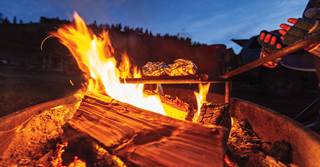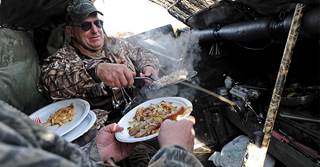Cooking in the Great Outdoors
Food just tastes better outside, and these dishes will be a hit no matter your alfresco occasion
Food just tastes better outside, and these dishes will be a hit no matter your alfresco occasion
By Scott Leysath, Photography by Holly Heyser
There is something special about cookouts. They are usually as much about gathering with friends and family as they are about what's on the menu. Cooking in the backyard is normally pretty straightforward. Just inside, there is counter space for prep work, a refrigerator to keep everything cold, and a place to wash up afterward. But when it is time to take the show on the roadto a campground, duck blind, or tailgatethings can get a little more complicated.

Photo Montana Outdoor Imagery
The first few trips where I attempted any type of camp cooking began with a stop at the store to load up with several bags of groceries. Rather than trying to streamline the process, I just used a lot of coolers. There was the produce cooler, the meat cooler, and the beverage cooler... OK, two beverage coolers. I also needed prep tables, gallons of water, pots, pans, and wood for the fire. My truck looked like I was moving across the country, and I spent a lot of time cooking while everyone else was hiking, fishing, or relaxing.
I eventually figured out that I could save lots of time, trouble, and space by going grocery shopping a day or two before my trip and by doing the majority of the prep work in advance. I trimmed, sliced, and diced vegetables. I processed meats. I even prepared complete meals, which I could freeze and pack for travel. If you want to serve a delicious meal in the outdoors and still have time for fun, I discovered, you should do as much as you can before you leave home.

Photo Holly Heyser

Photo Adobe Stock/Sean Locke Photo
Cooking on the tailgate of a pickup is not limited to traditional sporting events. Field trials, four-wheeling, and day camping are great excuses for throwing down some chow on the back of a truck. One of the advantages is that the truck bed can hold some luxuries like portable chairs, tables, and an extra cooler or two.
My favorite tailgate meal includes grilled duck breast fillets that have been brined and marinated, served with seasonal vegetables. Nothing packaged or canned, just whatever game I have left over from the past season and some good, fresh produce. For those who don't want to fire up the grill, I've also included a recipe for boil-in-bag goose barbecue sandwiches. Just drop vacuum-sealed packages of meat and sauce in boiling water. It doesn't get any easier.

Photo Holly Heyser
To save room in the cooler, I like to place prepped vegetables inside resealable plastic bags and then place those bags inside vacuum-sealed bags. Once you open the vacuum-sealed bags, the inner bags can be resealed in case you do not use all the vegetables at once. If you do not own a vacuum-sealer, freezer-safe resealable bags will do, but make sure to squeeze out as much air as possible before loading them into the cooler, and double-bag items that will expand when frozen.

Photo Holly Heyser
Whenever possible, I prefer waterfowl breast fillets with the skin intact, especially puddle ducks. For darker-fleshed divers and sea ducks, I remove the skin, as it has a tendency to absorb unsavory flavors.
INGREDIENTS
DIRECTIONS
[STEP 1] Stir together the soy sauce, honey, garlic, onion, and rosemary. Pour this mixture over the fillets and vegetables and marinate for 2 to 6 hours.
[STEP 2] Place the vegetables and the duck breast fillets, skin side down, on a hot grill. Once the skin on the fillets is evenly browned and crispy, flip them over and cook until evenly browned on the other side. For medium-rare, the internal temperature should be 130 to 140 degrees. Grill the vegetables on both sides until browned.
[STEP 3] Carve fillets into thin slices and arrange on a platter with grilled vegetables.
Brining Tips
Soaking your waterfowl in a solution of salt and brown sugar will add flavor and moisture while leaching out any gamey taste. The process is simple: Combine two cups of water with 1/2 cup coarse salt and 1/2 cup brown sugar. Heat the mixture in a pan until the salt is dissolved, let it cool, and then stir it into 1/2 gallon of water that has been cooled to below 40 degrees. Add the meat and let it soak for 12 to 24 hours in the refrigerator. Then remove the meat from the brine and pat dry. (Note: Brining meats adds a hint of salty flavor, so reduce the amount of salt in the rubs or marinades that you use on brined meats.)

Photo Holly Heyser
MAKES: 6 TO 8 SERVINGS
For this recipe, the majority of the work is done at home. After soaking in a brine and braising in a liquid until they're fall-apart tender, the sinewy goose breasts are transformed into a dish reminiscent of pulled pork. If you pack the cooled and shredded meat in vacuum-sealed bags, you can place the bags in hot water to bring the meat up to serving temperature.
INGREDIENTS
DIRECTIONS
[STEP 1] Season the goose breast fillets liberally with salt and pepper. Heat oil in a large oven-safe skillet or roasting pan. Add fillets and brown on all sides. Add celery, carrot, and onion to the pan along with enough liquid (wine, beer, or broth) to just cover the meat and vegetables. Bring to a boil, then reduce heat to low.
[STEP 2] Cover the pan with heavy-duty foil or a tight-fitting lid. Simmer on the stovetop for 3 to 4 hours or place in a 325-degree oven. After an hour, check to make sure that there is at least an inch of liquid in the pan. Add additional wine, beer, or stock as needed. When done, the fillets should be super tender and shred with minimal pressure.

Photo Holly Heyser
[STEP 3] Remove the fillets from the pan and shred them. Add barbecue sauce to coat. Let the meat cool, and then vacuum-seal it or place it in a resealable plastic bag for freezing or transport.
[STEP 4] To serve, heat the goose meat by placing the vacuum-sealed bags in hot water. (Note: Do not place resealable plastic bags in hot water. Instead, remove the goose meat from the bags and heat in a skillet or pot.) Add additional barbecue sauce if desired. Place on buns and top with coleslaw.

Photo Holly Heyser

Photo Jim Thompson
Preparing a hot meal in the duck blind has become an auxiliary sport for many of us who wake up early in anticipation of shooting a duck or two. In many areas, a mid- or late-morning mallard flight arrives after many hunters have left the field. Why not stick around and fire up a pot of something warm while you're waiting for the action to pick up? It sure beats going to work.
Duck blind chefs can learn a lot from backpackers, who know the importance of a light pack and a hearty meal at the end of a day on the trail. Prepared freeze-dried meals are OK, but you can save a bundle and prepare something even better by creating your own lightweight dinner.

Photo Holly Heyser
Few things beat the reward of a creamy chowder made with fresh-caught fish. Bring along a little extra shelf-stable bacon just in case the fishing part doesn't work out.
INGREDIENTS
DIRECTIONS

Photo Holly Heyser
In a pot, combine the water, oil, and bouillon and bring to a boil. Add in remaining ingredients except fish and oyster crackers, stir well, and cover tightly. Bring to a boil, then reduce heat and simmer for 3 to 4 minutes. Add fish fillets and simmer until fish is just cooked, about another 3 minutes. Serve with oyster crackers.

Photo Holly Heyser

A portable cooking kit stocked with spices and utensils is an invaluable tool for the outdoor chef, and a duck hunter's blind bag makes a perfect organizer. Blind bags are sturdy and usually have multiple pockets and compartmentssome are even washable. When packed properly, many blind bags are large enough to carry your cooking and hunting gear, and your pals will thank you when you hand them a warm bowl of mid-morning duck stew that you prepared at home and packed in your bag along with calls, shells, and coffee.

Photo Holly Heyser
Dutch oven pros crank out some amazing dishes, from hearty breakfasts to sinful desserts. But for many of us, Dutch oven cooking can seem a bit mysterious. The secret is knowing how many white-hot coals to place underneath the oven and on top of the lid to create the perfect temperature inside.
I learned most of what I know about Dutch oven cooking from backcountry cooking pro Butch "Cee Dub" Welch. He spent 21 years as a conservation officer for Idaho Fish and Game while earning legend status as a camp cook. My favorite Cee Dub quote is: "If it smells done, it's done. If it smells burnt, it's burnt. If you can't smell it, it's not done."
While Dutch ovens are often used for soups, stews, and other big-batch recipes, they're also great for making desserts. Those desserts can be as complicated as a 12-layer cake or as simple as the recipe below.

Photo Holly Heyser
SERVES: 8 TO 10
This is actually the creation of Cee Dub's wife, Penny. It is always a big hit with campers of all ages.
INGREDIENTS
DIRECTIONS
[STEP 1] Melt butter and brown sugar in the bottom of a 12-inch Dutch oven. Pour in undrained pineapple and spread it evenly over the surface of the oven.

Photo Holly Heyser
[STEP 2] Sprinkle the dry cake mix over the pineapple mixture and then gently pour the lemon-lime soda over the cake mix.

Photo Holly Heyser
[STEP 3] Cover and bake for 40 to 50 minutes using 6 to 8 briquettes under the Dutch oven, 20 on the outside rim of the lid, and 3 to 4 in the middle of the lid. While baking, give the Dutch oven and the lid a quarter turn every 15 minutes or so to minimize hot spots.
[STEP 4] Spoon into bowls and top with ice cream or whipped cream.

Photo Holly Heyser
When lighting charcoal for Dutch oven cooking or everyday grilling, the most efficient way is with a charcoal chimney and your gas grill. Simply load up the chimney with charcoal and place it over the open burner. When you see wisps of flame rising over the top of the chimney, dump the hot coals onto a metal surface like a garbage can lid. The metal will keep the coals hot longer than if they were dumped onto the cold ground.
Ducks Unlimited uses cookies to enhance your browsing experience, optimize site functionality, analyze traffic, and deliver personalized advertising through third parties. By continuing to use this site, you agree to our use of cookies. View Privacy Policy